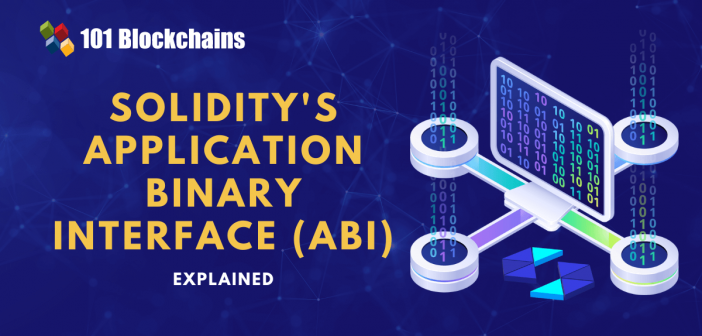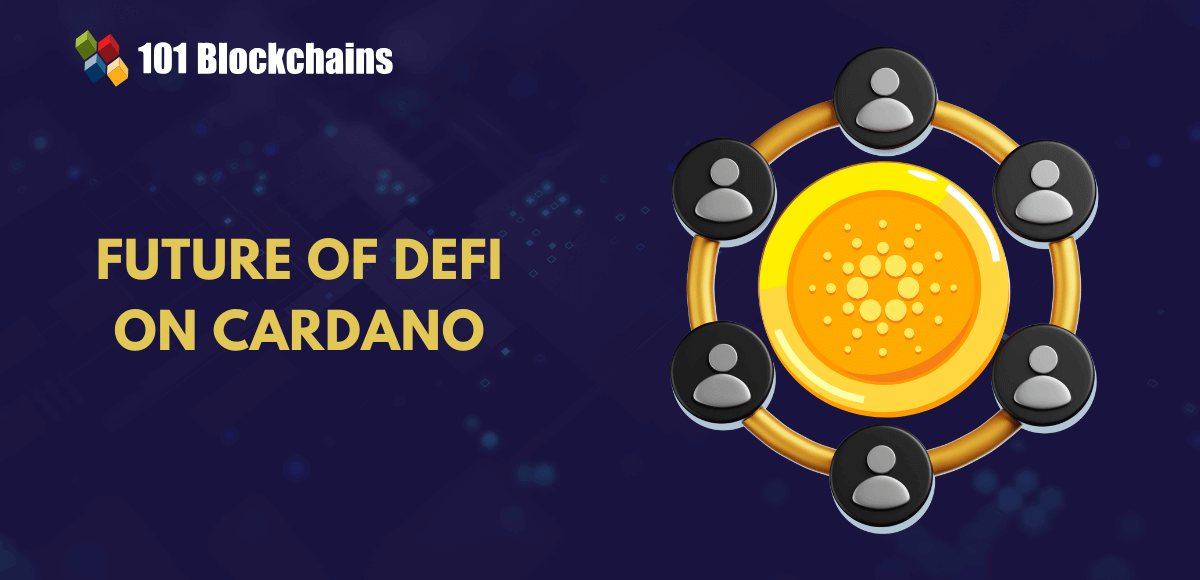Learn how blockchain truly works, master key definitions, and uncover what makes smart contracts so "smart." Dive into the fundamentals, gain valuable insights, and start your blockchain journey today!

- Solidity & Smart Contracts
James Howell
- on October 28, 2022
Everything You Need to Know About Solidity’s Application Binary Interface (ABI)
The interest in Solidity has been strengthening profoundly in recent times. Many developers want to capitalize on the programing language and create smart contracts for various decentralized applications. Solidity is the preferred programming language for creating smart contracts on the Ethereum blockchain and makes it to the list of top programming languages trusted by blockchain and web3 beginners.
Interestingly, one of the important concepts related to Solidity, which is crucial for ensuring its functionalities, is the Solidity ABI or Application Binary Interface. What do you know about the ABI of Solidity and its functions? Is it an integral component of the Solidity programming language? The following discussion offers you an introduction to the ABI in Solidity and its working. You can also learn about the significant reasons which validate the significance of the Application Binary Interface with Solidity.
Are you aspiring to learn the fundamentals of the Ethereum Virtual Machine and smart contracts’ upgradability? Enroll now in the Advanced Solidity Development Course.
Important Concepts to Learn for Understanding ABIs
If you want to find out the meaning of Solidity Application Binary Interface, then you must be prepared to understand other aspects of the role of Solidity developers. Any Solidity developer would have to deal with EVM, the smart contract code, and the application binary interface. Let us reflect on the details of these components to obtain a better impression of how ABIs work on Solidity.
-
Ethereum Virtual Machine
The definition of an Application Binary Interface in Solidity would also emphasize the compilation of smart contracts with Solidity particularly. You can think of Ethereum Virtual Machine or EVM as one of the significant factors required for compiling smart contracts with Solidity. Virtual machines are generally tailored to offer the functionalities of hardware and could serve better efficiency in scalability, management, and updates for the infrastructure running software applications.
The Ethereum Virtual Machine is also a type of virtual machine which can help in creating a decentralized system or environment based on many networked nodes. All the nodes connect together to serve the functionalities of one machine. Every node relies on client software implementing Ethereum specifications, and the connection between them leads to the formation of a network. The network of computers could then synchronize the data for creating a large database through agreement on the state of data through a consensus algorithm.
Excited to learn the basic and advanced concepts of ethereum technology? Enroll now in Ethereum Technology Course
-
Smart Contracts
The purpose of Solidity focuses solely on the creation of smart contracts, and the EVM is responsible for running the smart contracts. Just like other applications, you can write the code for the smart contract followed by ensuring its compilation before deploying on the Ethereum blockchain.
After deploying the code on Ethereum blockchain, you do not have the opportunity of returning back. The EVM would serve as the environment for executing the code or the virtual machine for the operations of smart contracts deployed on them. How is smart contract compilation relevant for Solidity developers?
Developers would create human-readable code in the programming languages of their choice for the advantage of flexible reading, editing, debugging, and maintenance tasks for applications. However, the machine or the EVM could not understand human-readable languages.
Machines would rely on Solidity Binaries to understand the context of the smart contract code. The binary data would appear like a flow of ones and zeros. Developers can enable the machine to read code by passing it through the compiler, which converts code into machine-readable language.
When you pass the Solidity code through a compiler, you can find two resultant products. One of the resultants is the Application Binary Interface, while the other one is the machine-readable code. You can continue the journey of understanding ABI on Solidity by learning more about machine-readable code and its significance.
Curious to understand the complete smart contract development lifecycle? Enroll now in Smart Contracts Development Course
-
Machine-Readable Code
As the EVM is not capable of interpreting human-readable languages, you need to pass it through a compiler to ensure that it becomes machine-readable. You can also find a common name for machine-readable code in Solidity terminology as bytecode, and it contains instructions for the machine in binary format.
The overall composition of the machine-readable code includes compact numeric codes alongside constants and additional information pointers. All the instruction steps within the code refer to a specific operation, also referred to as opcodes, which generally feature a length of one byte. Therefore bytecodes derive their name from the abridging of “one-byte” and “opcodes.”
All the lines of code are divided into opcodes, thereby directing the computer exactly about the activities required for running code. In the case of Ethereum, the machine-readable code is deployed on the Ethereum blockchain. After deploying the machine-readable code on the Ethereum blockchain, users can confirm the transaction by using a browser-based wallet.
Prior to an explanation for Solidity ABI, the basics of bytecodes can serve as a promising advantage for beginners. The machine-readable code goes directly into the Ethereum network upon the interaction of users with smart contracts. In addition, you can discover many other libraries and tools for the compilation of Solidity code.
Want to learn the basic and advanced concepts of Ethereum? Enroll in our Ethereum Development Fundamentals Course
Definition of Application Binary Interfaces (ABIs)
After a detailed understanding of the essential components involved in Solidity smart contracts execution, you can move toward the main topic at hand. The understanding of the Solidity Application Binary Interface might seem a bit complicated in the beginning. However, you need to learn about ABIs to ensure that you can leverage their functionalities effectively as Solidity developers.
Have you heard about application programming interfaces or APIs? The APIs are practically the collections of different functions, methods, constants and variables, which can help you interact with network endpoints, backend services or libraries as well as other popular software applications and services. APIs are also one the favorable opportunities for pointing out the functionalities of specific software with a controlled, intuitive and stable approach. In a way, APIs serve as an interface between two software applications or components.
You can also look forward to answers on “How do ABIs work in Solidity?” by reflecting on the basics of the working of APIs. The Application Binary Interfaces or ABIs provide a definition for methods and variables in a smart contract to enable interactions with it. Smart contract code goes through conversion to machine-readable format before deployment on the blockchain.
Therefore, you need a proven method for identifying the interactions and operations you can initiate with the concerned smart contract. In such cases, programmers need standardized methods for expressing the interfaces to enable all programming languages with capabilities for smart contract interaction. With the ABI for a smart contract, users can interact with a smart contract.
Build your identity as a certified blockchain expert with 101 Blockchains’ Blockchain Certifications designed to provide enhanced career prospects.
What Does an ABI Include?
The machine-readable code with Solidity Binaries can be easier for the EVM to understand, albeit with difficulties for human-readable programming languages. ABIs solve the problem by enabling a bridge between different smart contracts. Application Binary Interfaces are basically the definitions that help in defining the parameters, data types, method names, and arguments for interacting with a smart contract. In addition, ABIs also provide the definition for the structure of events associated with the smart contract. Some of the important properties found in ABI which can offer the desired functionalities include the following.
- ‘type’ helps in specifying the nature of the function and could include one from the function, fallback, receive, or constructor.
- ‘inputs’ are another significant parameter included in an Application Binary Interface in Solidity and indicate the array of objects. It should focus specifically on the schema for the array of objects, including the name for the parameter and type. In addition, the ‘inputs’ value for the ABI would also include details about the “components” in its schema, especially when the type works as a tuple.
- The ‘name’ property in ABI is straightforward and provides information about the name of the function.
- You would also find the ‘outputs’ feature in the ABI, which can specify an array of objects just like the ‘inputs’ parameters.
- ABIs also include the ‘stateMutability’ parameter, which is a string specifying the state mutability of the concerned paragraph. It is also important to note that the ‘stateMutability’ of the function would lead to specific values such as pure, payab <, nonpayab < and view.
Generally, ABIs are articulated in JSON formats, and an example could look like the following,
[ { "inputs": [], "stateMutability": "nonpayable", "type": "constructor" }, { "inputs": [], "name": "getLatestPrice", "outputs": [ { "internalType": "int256", "name": "", "type": "int256" } ], "stateMutability": "view", "type": "function" } ]
Excited to learn about the key elements of Solidity? Check the presentation Now on Introduction To Solidity
Working of Application Binary Interfaces
The guide to application binary interfaces for Solidity would remain incomplete without reflecting on the details of how they work. Interestingly, you must have figured out a basic impression of the working of ABIs from the details of the smart contract compilation process. Let us retrace the steps and important components which lead to the creation of the Application Binary Interfaces.
Compilation
The first and integral step in ensuring the functions of Solidity would refer to compilation of smart contracts. Compilation basically refers to the conversion of Solidity smart contract code into machine-readable Ethereum Virtual Machine code. The EVM could not understand Solidity programming code and relied on the Solidity Compiler for processing smart contracts. It is important to note that the compiler, also referred to as solc, works on the compilation of Solidity smart contracts into EVM-supported code alongside ABI. This offers a clear impression of how ABIs come into existence.
Want to get an in-depth understanding of Solidity concepts? Enroll now in Solidity Fundamentals Course
Role of ABIs
Once the compilation process is done, you can find the smart contract code covered to bytecode within the EVM. On the other hand, external applications and other smart contracts have their version of the smart contract code in Solidity programming language. Therefore, the Application Binary Interface or ABI becomes one of the significant components associated with smart contract operations on Solidity.
Application Binary Interface or ABI works like an interpreter for external applications and smart contracts for easier interaction with EVM. The Solidity Application Binary Interface includes a human-readable collection of methods on smart contracts for facilitating access to specific functions. Developers can implement the ABI with other libraries, such as Ethers.js, to enable interactions with smart contracts.
How is an ABI different from API? APIs or application programming interfaces could serve as an interaction between web applications and centralized servers. On the other hand, Solidity ABI offers smart contract data for applications as well as other contracts. APIs could work for an application by requesting data from a server and then feeding the data into the application. On the other hand, ABIs could access smart contract data in binary format.
The most important component in the working of ABIs would refer to the Binaries. Solidity Binaries refer to the unique infrastructure for storing smart contract data within the Ethereum ecosystem. Developers could not use the human-readable Solidity smart contract code directly on the Ethereum blockchain. On the contrary, Binaries help in the cost-effective storage of data on the blockchain. In this case, you would have to learn about ABI encoding and decoding with Solidity.
ABI encoding refers to the process of encoding necessary information that the machine-readable data must process. On the other hand, ABI decoding refers to the conversion of machine-readable bytecode into human-readable language. With the help of decoding, you can obtain the Solidity code. The working of ABIs on Solidity practically focuses on translation between human-readable and machine-readable code on Solidity and EVM.
Here is an outline of the distinct steps involved in the working of an ABI transaction on Solidity.
- Smart contract ABI is offered to the frontend library, such as EtherJS.
- The frontend library would then work on the translation of the method call and arguments into call data, which has to be offered to an Ethereum node as a transaction.
- Creation of a receipts trie after validating the transaction, with a detailed outline of the transaction logs and transaction fees consumed in the transaction.
Master the art of Smart Contract development with Solidity to create innovative web3 applications for diverse use cases as a Solidity expert with Solidity Skill Path
Bottom Line
The detailed outline of Solidity Application Binary Interface and its working provided a comprehensive explanation for working smart contracts. Solidity is one of the popular languages for smart contract development and operations. With the help of ABIs, you can enjoy the benefits of seamless interactions with smart contracts of your choice.
Application Binary Interfaces are somewhat similar to APIs, albeit with a specialized focus on Solidity smart contracts. The ABIs can deliver promising results in terms of the interpretation of EVM bytecodes to human-readable Solidity code and vice-versa. Start learning more about ABIs and how they can support the future of smart contracts now.
*Disclaimer: The article should not be taken as, and is not intended to provide any investment advice. Claims made in this article do not constitute investment advice and should not be taken as such. 101 Blockchains shall not be responsible for any loss sustained by any person who relies on this article. Do your own research!





